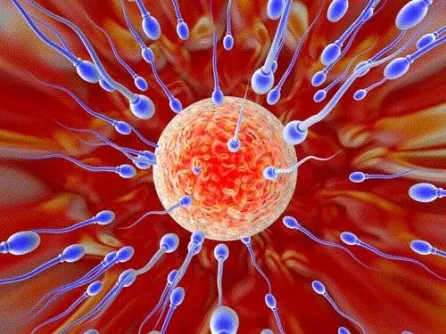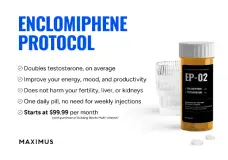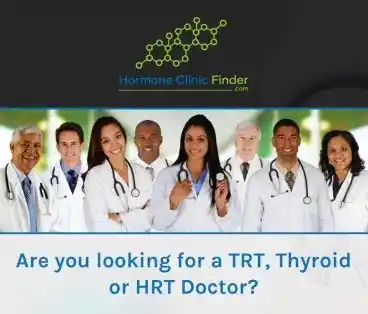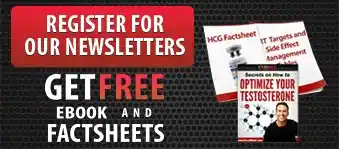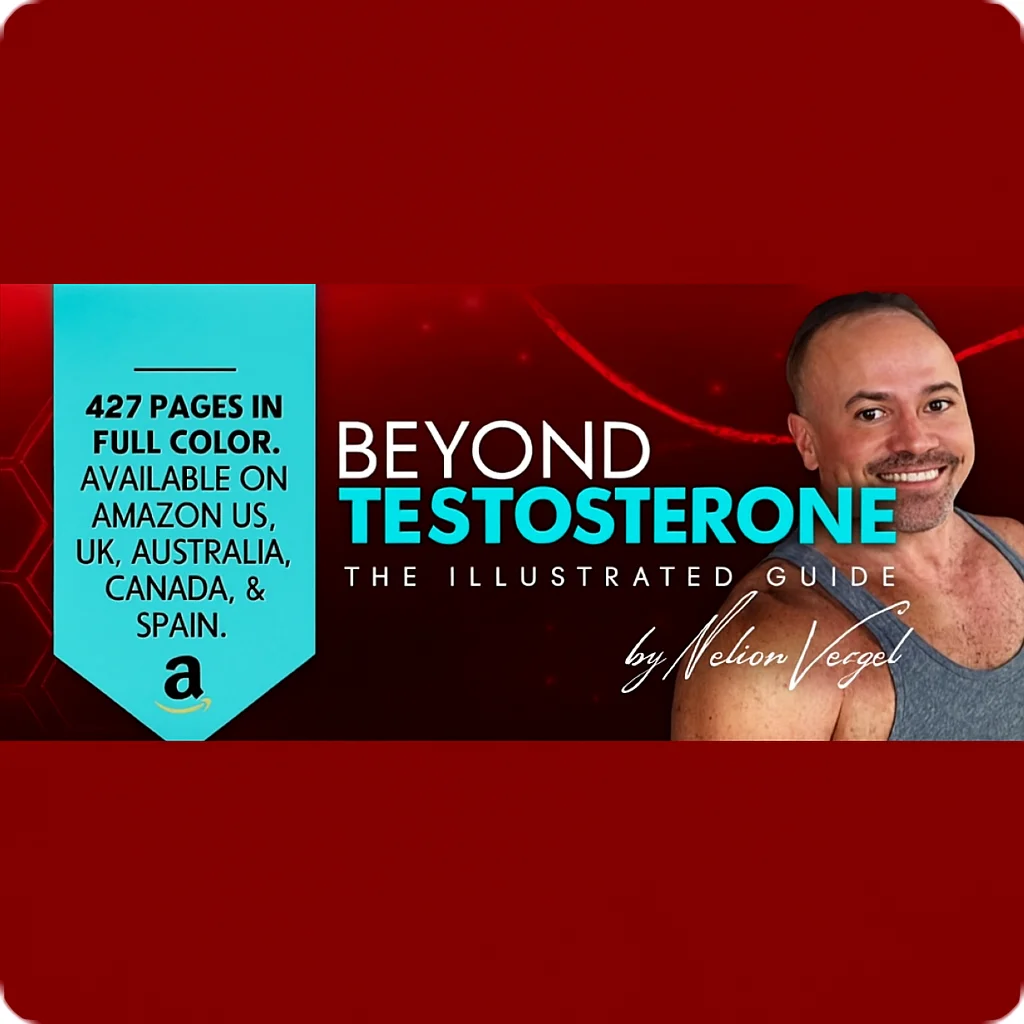Using hCG in Men on Testosterone Replacement Therapy (TRT) – A Clinical Review
Introduction
Exogenous testosterone replacement therapy (TRT) can profoundly suppress the hypothalamic-pituitary-gonadal (HPG) axis through negative feedback. By inhibiting gonadotropin-releasing hormone (GnRH) and pituitary luteinizing hormone (LH) and follicle-stimulating hormone (FSH) release, TRT often leads to markedly reduced intratesticular testosterone (ITT) levels and impaired spermatogenesis ¹ ². Clinically, men on TRT frequently experience testicular atrophy, low or zero sperm counts (azoospermia), and reductions in other testicular hormones. Current medical guidelines caution against using TRT in men who desire future fertility ¹ ³. For hypogonadal men of reproductive age, alternative strategies such as selective estrogen receptor modulators (e.g. clomiphene) or gonadotropin therapy are recommended to maintain fertility ¹.
Human chorionic gonadotropin (hCG) is a placental glycoprotein hormone that mimics the action of LH in men. It shares the same receptor as LH (the LH/hCG receptor) and has a longer half-life (~36 hours vs. 30 minutes for LH), making it a potent and durable LH analog ². In men with suppressed gonadotropins (e.g. due to TRT or anabolic steroid use), hCG can selectively stimulate the testes by binding LH receptors on Leydig cells²². This review examines evidence from peer-reviewed clinical studies and guidelines on the benefits of adjunctive hCG in men undergoing TRT, specifically:

Mechanism of hCG in the HPG Axis during TRT
TRT-Induced HPG Suppression: Exogenous testosterone causes dose-dependent suppression of GnRH, LH, and FSH via negative feedback¹. With endogenous LH and FSH near zero, testicular Leydig cell activity plummets. The concentration of testosterone inside testicular cells, or intratesticular testosterone (ITT), normally far exceeds serum T (ITT can be ~50-100 times higher) and is required for normal sperm production⁴⁴. Within weeks of starting TRT, ITT and sperm output decline sharply; clinical studies have shown that TRT (e.g. 100- 200 mg testosterone enanthate weekly) can cause azoospermia in a majority of men by ~10 weeks². One classic WHO study reported about 65% of men became azoospermic after 6 months of 200 mg/week testosterone, with the remainder having severe oligospermia¹¹. Cessation of TRT eventually allows recovery of pituitary function and spermatogenesis in most men, but this may take many months and is not guaranteed in all cases¹¹. Notably, a small percentage (~10%) of men may remain azoospermic even long after stopping TRT².
hCG as an LH Mimetic: Human chorionic gonadotropin binds to the same LH receptors on Leydig cells, triggering the steroidogenic cascade that leads to testosterone synthesis²². By “replacing” the missing LH signal, hCG can maintain testicular testosterone production even while the HPG axis is suppressed by exogenous T. Mechanistically, hCG stimulates the conversion of cholesterol to pregnenolone in the testes (via the enzyme P450scc), the first step in steroidogenesis. A classic study by Martikainen et al. (1982) demonstrated that a single hCG injection in men rapidly increased levels of upstream steroid intermediates in testicular venous blood: within 30 minutes of 5,000 IU hCG, spermatic vein levels of pregnenolone, progesterone, 17-hydroxyprogesterone, androstenedione, testosterone, and DHT all rose significantly⁵. By 4 days post-hCG, peripheral blood levels of testosterone, DHT, estradiol, and 17-OH progesterone were markedly elevated as well⁵. These results directly demonstrate that the human testis responds rapidly to hCG stimulation, restoring activity of the steroidogenic pathway from pregnenolone onward⁵⁵. In practical terms, co-administering hCG with TRT can maintain intratesticular steroid production (and thus normal physiology in the gonads) despite continued exogenous testosterone use²².
Another important aspect is FSH. While LH/hCG primarily stimulates Leydig cells to produce testosterone (and other steroids), FSH acts on Sertoli cells and is important for quantitatively normal spermatogenesis. TRT suppresses both LH and FSH. hCG does not replace FSH; however, maintaining a high intratesticular testosterone via hCG is often sufficient to support ongoing sperm production to a significant degree²². In some scenarios (discussed later), adjunctive therapy with either selective estrogen receptor modulators (to raise endogenous FSH) or recombinant FSH is used alongside hCG to optimize fertility outcomes⁶².
In summary, hCG in the context of TRT acts by selectively reactivating testicular function that TRT alone would suppress. It essentially circumvents the pituitary shut-down by directly stimulating the testes, thereby preventing the cascade of adverse effects (testicular shrinkage, loss of sperm and steroid output) that result from gonadotropin deficiency during TRT.
Prevention of Testicular Atrophy
One visible consequence of TRT-induced gonadotropin suppression is testicular atrophy – a reduction in testis volume. Testicular size is largely maintained by active spermatogenesis and Leydig cell function; without LH and FSH stimulation, the testes can shrink substantially, often causing concern for patients⁶⁶. In fact, testicular atrophy on TRT reflects the combined loss of germ cell output (sperm) and Leydig cell activity⁷.
Co-administration of hCG with TRT has been shown to mitigate or prevent TRT-related testis shrinkage. By keeping the intratesticular testosterone levels in the normal range, hCG helps preserve testicular structure and function. Clinical evidence: Hsieh et al. (2013) retrospectively studied 26 hypogonadal men (average age ~36) on TRT who received concomitant low-dose hCG (500 IU every other day). Over a mean follow-up of 6 months, no patient developed azoospermia and notably no testis atrophy was observed while on combined TRT+hCG therapy¹. In contrast, men on TRT alone typically experience progressive testis shrinkage⁸. A 2021 prospective study in men with hypogonadotropic hypogonadism by Shiraishi et al. directly compared hCG versus testosterone therapy: TRT caused a clear decrease in testicular volume, whereas hCG maintained or increased testis size (since hCG was essentially simulating natural gonadotropin support)⁸⁸.
Moreover, the review by Lee and Ramasamy (2018) emphasizes that hCG is used to reduce TRT side effects, “mainly preventing testicular atrophy”, in men who undergo long-term TRT². Even in men who do not desire fertility, low-dose hCG is sometimes added to TRT protocols specifically to preserve testicular morphology and potentially to avoid discomfort associated with shrunken testes². For example, one suggested regimen for purely maintaining testicular size in a man on TRT is hCG 1,500 IU weekly, which was reported to be “enough to maintain pre-TRT levels of intratesticular testosterone” and thus prevent atrophy². Taken together, the evidence strongly supports hCG’s role in sustaining testicular volume during TRT by keeping the testes functionally active.
Preservation of Fertility (Sperm Count and Quality)
Impact of TRT on Fertility: Exogenous testosterone is a highly effective male contraceptive in many men. By suppressing LH and FSH, TRT can bring sperm production to a halt – resulting in low sperm counts or complete azoospermia in a significant fraction of users¹². Studies have documented that a majority of men (anywhere from ~65% to >90% in various trials) become azoospermic on high-dose TRT used experimentally as contraception¹. Even when azoospermia is not complete, sperm counts typically fall into the very low oligospermic range during TRT. This infertility is reversible in most (but not all) men after stopping testosterone, with a median time to sperm recovery of around 3–6 months (but up to 12+ months in some cases)¹¹. Because of this, clinical guidelines (Endocrine Society, AUA) advise that men who desire fertility should not be placed on testosterone therapy without counseling and consideration of alternatives¹³.
hCG to Maintain Spermatogenesis: The use of hCG alongside TRT has emerged as a strategy to preserve sperm production in men who require testosterone therapy. The rationale is that hCG maintains intratesticular testosterone (the key hormonal driver of spermatogenesis) despite exogenous T use. Evidence from human trials supports this approach:
Maintenance of Upstream Steroidogenic Hormones (e.g. Pregnenolone)
Beyond testosterone and sperm, the testes produce other hormones and precursors (often termed “upstream” steroidogenic hormones) that have systemic roles. One such hormone is pregnenolone, the first steroid in the synthesis pathway, which serves as a precursor for not only testosterone but also for other steroids (e.g. progesterone, DHEA, estrogen, and neurosteroids like allopregnanolone). Under normal physiology, LH stimulation of the Leydig cell initiates the conversion of cholesterol to pregnenolone; pregnenolone is then metabolized to other steroids both in the testis and peripherally.
Effect of TRT: When TRT suppresses LH, the entire testicular steroidogenic output is diminished. This means not just testosterone, but also intra-testicular and circulating levels of pregnenolone and related C21 steroids can decline (since the testis is quiescent). Some men on long-term TRT report low pregnenolone or DHEA-S levels, which has led to speculation that the absence of intratesticular steroidogenesis might affect things like mood, cognition, or adrenal steroid balance (though the adrenal glands produce pregnenolone as well, they may not fully compensate for the testicular contribution in some individuals).
hCG’s Role: By reactivating testicular steroid production, hCG can restore normal or near-normal levels of these upstream hormones. The previously mentioned study by Martikainen et al. (1982) clearly showed that hCG rapidly increases pregnenolone and progesterone output from the testes⁵. Within 30 minutes of hCG administration, pregnenolone levels in the spermatic vein rose significantly, indicating an acute upregulation of the side-chain cleavage of cholesterol⁵. After several days of continued hCG stimulation, peripheral blood measures confirmed higher levels of 17-hydroxyprogesterone, DHEA/DHT, and even estradiol (reflecting increased aromatization from the newly produced androgens)⁵. Essentially, hCG restores a more physiologic hormone milieu by ensuring the testes contribute their normal array of steroids.
Clinically, the benefit of this may be subjective but important. Some men on TRT report improved cognitive function, mood, and overall well-being when hCG is added – possibly due to the restoration of neurosteroid precursors like pregnenolone and allopregnanolone that modulate brain function⁹. While rigorous clinical trials on neurosteroids in TRT are lacking, it is plausible that maintaining pregnenolone production via hCG could have downstream benefits (pregnenolone is known to influence memory, stress, and neuroprotection in research settings). Additionally, maintaining some level of testicular estrogen production via hCG may help intra-testicular paracrine signaling and sperm maturation, although too high hCG doses can elevate estradiol excessively (careful dosing is addressed below).
In summary, hCG helps preserve the entire steroidogenic output of the testes, not just testosterone. By doing so, it ensures that upstream hormones like pregnenolone and progesterone (and their metabolites) remain at physiologic levels during TRT. This may contribute to better mood, energy, or sexual function, complementing the direct effects of TRT. It also prevents the complete silencing of pathways that might have long-term health implications if suppressed (though more research is needed on these outcomes).
hCG Dosing and Administration Protocols with TRT
Clinical practice and research have converged on several protocols for using hCG in conjunction with TRT. The appropriate regimen can vary based on the patient’s goals (e.g. immediate fertility vs. future fertility vs. just mitigating side effects). Key principles include using the lowest effective hCG dose to achieve desired intratesticular testosterone levels and sperm production, while avoiding excessive doses that might cause estrogenic side effects or desensitization of Leydig cells.
Common Low-Dose Protocol (for maintenance): For men on TRT who wish to preserve fertility or testicular function, low-dose hCG therapy is typically employed. A very common regimen is hCG 500 IU administered subcutaneously 2–3 times per week (roughly every other day). This protocol was derived from studies like the Coviello trial and the Hsieh clinical series, which showed 500 IU QOD to be effective in maintaining ITT and sperm counts²,¹. Many clinicians simplify this to 500 IU twice weekly (for example, Mondays and Thursdays) or three times weekly, which patients find convenient and which provides roughly 1,000–1,500 IU total per week. Notably, 250 IU every other day is another evidence-backed dosing (as Coviello et al. demonstrated that 250 IU QOD was almost as effective as 500 IU in preserving intratesticular testosterone)². In practice, doses in the range of 350–500 IU two to three times weekly are most commonly used for maintenance of fertility during TRT¹. These doses generally keep serum testosterone in the target range (set by TRT dosing) while adding just a slight additional boost from the testes; they also tend to elevate estradiol only moderately, which can often be managed without aromatase inhibitors.
High-Dose Protocols (for active fertility attempts): If a man on TRT actively wants to conceive in the near term, many experts will escalate hCG dosing or even temporarily replace TRT with hCG. The 2018 consensus by Lee & Ramasamy suggests a decision based on the desired timeline to pregnancy²:
(Note: IU = International Units; SC = subcutaneous; QOD = every other day; FSH = follicle-stimulating hormone.)
In all cases, when using hCG, clinicians monitor patient response – including testosterone and estradiol levels, hematocrit, testicular size, and semen analyses if applicable. Side effects of hCG are generally mild at these doses, but can include elevated estradiol (since hCG-driven testicular T can aromatize to E2) and in rare cases gynecomastia or mood changes. If estradiol rises excessively, dose reduction or adding an aromatase inhibitor can be considered, though the latter is avoided unless necessary. Desensitization of Leydig cells to hCG is not typically an issue at physiologic dosing schedules (continuous high-dose hCG can downregulate receptors, but the low-dose intermittent protocols used with TRT have not shown significant tachyphylaxis in studies up to 1–2 years)²².
Clinical Outcomes and Benefits in Practice
Real-world clinical outcomes with combined TRT + hCG (or hCG monotherapy) have been encouraging, both in terms of objective measures and patient-reported outcomes:
As always, therapy should be individualized: men desiring fertility should be counseled about options (including hCG or clomiphene instead of TRT altogether), and those on TRT with hCG should be followed with appropriate lab tests and semen analyses as needed. With proper dosing and monitoring, hCG is a valuable adjunct in the management of hypogonadal men, effectively addressing the key drawbacks of TRT (infertility and atrophy) while allowing continued symptom control¹⁶.
Sources:
1. Coviello, A. D., Matsumoto, A. M., Bremner, W. J., et al. (2005). Low‑dose human chorionic gonadotropin maintains intratesticular testosterone in normal men with testosterone‑induced gonadotropin suppression. Journal of Clinical Endocrinology & Metabolism, 90(5), 2595–2602. Low-dose human chorionic gonadotropin maintains intratesticular testosterone in normal men with testosterone-induced gonadotropin suppression - PubMed
2. Hsieh, T. C., Pastuszak, A. W., Hwang, K., et al. (2013). Concomitant intramuscular human chorionic gonadotropin preserves spermatogenesis in men undergoing testosterone replacement therapy. Journal of Urology, 189(2), 647–650. Concomitant intramuscular human chorionic gonadotropin preserves spermatogenesis in men undergoing testosterone replacement therapy - PubMed
3. Lee, J. A., & Ramasamy, R. (2018). Indications for the use of human chorionic gonadotropic hormone for the management of infertility in hypogonadal men. Translational Andrology and Urology, 7(Suppl 3), S348–S352. Indications for the use of human chorionic gonadotropic hormone for the management of infertility in hypogonadal men - PubMed
4. Ramasamy, R., Armstrong, J. M., & Lipshultz, L. I. (2015). Preserving fertility in the hypogonadal patient: an update. Asian Journal of Andrology, 17(2), 197–200. Mar-Apr 2015 - Volume 17 - Issue 2 : Asian Journal of Andrology
5. Shiraishi, K., et al. (2021). Patient‑reported outcomes and biochemical alterations during hCG versus testosterone treatment in men with hypogonadotropic hypogonadism. Endocrine Journal, 68(2), 221–229. Patient-reported outcomes and biochemical alterations during hormonal therapy in men with hypogonadotropic hypogonadism who have finished infertility treatment - PubMed
6. Martikainen, H., et al. (1982). Influence of hCG treatment on the metabolism of progesterone and pregnenolone. Journal of Steroid Biochemistry, 16(2), 287–291. Influence of hCG treatment on the metabolism of progesterone and pregnenolone in vitro by the human undescended prepubertal testis - PubMed
7. Desai, A., Calaway, A., & ... et al. (2017). Exogenous testosterone: a preventable cause of male infertility. Therapeutic Advances in Urology, 9, 389–400. Exogenous testosterone: a preventable cause of male infertility - PubMed
Mulhall, J. P., Trost, L. W., Brannigan, R. E., et al. (2018). Evaluation and management of testosterone deficiency: AUA guideline. The Journal of Urology, 200, 423–434. Evaluation and Management of Testosterone Deficiency: AUA Guideline - PubMed
Introduction
Exogenous testosterone replacement therapy (TRT) can profoundly suppress the hypothalamic-pituitary-gonadal (HPG) axis through negative feedback. By inhibiting gonadotropin-releasing hormone (GnRH) and pituitary luteinizing hormone (LH) and follicle-stimulating hormone (FSH) release, TRT often leads to markedly reduced intratesticular testosterone (ITT) levels and impaired spermatogenesis ¹ ². Clinically, men on TRT frequently experience testicular atrophy, low or zero sperm counts (azoospermia), and reductions in other testicular hormones. Current medical guidelines caution against using TRT in men who desire future fertility ¹ ³. For hypogonadal men of reproductive age, alternative strategies such as selective estrogen receptor modulators (e.g. clomiphene) or gonadotropin therapy are recommended to maintain fertility ¹.
Human chorionic gonadotropin (hCG) is a placental glycoprotein hormone that mimics the action of LH in men. It shares the same receptor as LH (the LH/hCG receptor) and has a longer half-life (~36 hours vs. 30 minutes for LH), making it a potent and durable LH analog ². In men with suppressed gonadotropins (e.g. due to TRT or anabolic steroid use), hCG can selectively stimulate the testes by binding LH receptors on Leydig cells²². This review examines evidence from peer-reviewed clinical studies and guidelines on the benefits of adjunctive hCG in men undergoing TRT, specifically:
- Prevention of testicular atrophy
- Preservation or restoration of fertility (sperm count and quality
- Maintenance of upstream steroidogenic hormones (e.g. pregnenolone)
- The mechanism of hCG action on the HPG axis during TRT
- Common clinical dosing protocols for hCG with TRT
- Clinical outcomes observed (symptom relief, hormone levels, and fertility metrics)
Mechanism of hCG in the HPG Axis during TRT
TRT-Induced HPG Suppression: Exogenous testosterone causes dose-dependent suppression of GnRH, LH, and FSH via negative feedback¹. With endogenous LH and FSH near zero, testicular Leydig cell activity plummets. The concentration of testosterone inside testicular cells, or intratesticular testosterone (ITT), normally far exceeds serum T (ITT can be ~50-100 times higher) and is required for normal sperm production⁴⁴. Within weeks of starting TRT, ITT and sperm output decline sharply; clinical studies have shown that TRT (e.g. 100- 200 mg testosterone enanthate weekly) can cause azoospermia in a majority of men by ~10 weeks². One classic WHO study reported about 65% of men became azoospermic after 6 months of 200 mg/week testosterone, with the remainder having severe oligospermia¹¹. Cessation of TRT eventually allows recovery of pituitary function and spermatogenesis in most men, but this may take many months and is not guaranteed in all cases¹¹. Notably, a small percentage (~10%) of men may remain azoospermic even long after stopping TRT².
hCG as an LH Mimetic: Human chorionic gonadotropin binds to the same LH receptors on Leydig cells, triggering the steroidogenic cascade that leads to testosterone synthesis²². By “replacing” the missing LH signal, hCG can maintain testicular testosterone production even while the HPG axis is suppressed by exogenous T. Mechanistically, hCG stimulates the conversion of cholesterol to pregnenolone in the testes (via the enzyme P450scc), the first step in steroidogenesis. A classic study by Martikainen et al. (1982) demonstrated that a single hCG injection in men rapidly increased levels of upstream steroid intermediates in testicular venous blood: within 30 minutes of 5,000 IU hCG, spermatic vein levels of pregnenolone, progesterone, 17-hydroxyprogesterone, androstenedione, testosterone, and DHT all rose significantly⁵. By 4 days post-hCG, peripheral blood levels of testosterone, DHT, estradiol, and 17-OH progesterone were markedly elevated as well⁵. These results directly demonstrate that the human testis responds rapidly to hCG stimulation, restoring activity of the steroidogenic pathway from pregnenolone onward⁵⁵. In practical terms, co-administering hCG with TRT can maintain intratesticular steroid production (and thus normal physiology in the gonads) despite continued exogenous testosterone use²².
Another important aspect is FSH. While LH/hCG primarily stimulates Leydig cells to produce testosterone (and other steroids), FSH acts on Sertoli cells and is important for quantitatively normal spermatogenesis. TRT suppresses both LH and FSH. hCG does not replace FSH; however, maintaining a high intratesticular testosterone via hCG is often sufficient to support ongoing sperm production to a significant degree²². In some scenarios (discussed later), adjunctive therapy with either selective estrogen receptor modulators (to raise endogenous FSH) or recombinant FSH is used alongside hCG to optimize fertility outcomes⁶².
In summary, hCG in the context of TRT acts by selectively reactivating testicular function that TRT alone would suppress. It essentially circumvents the pituitary shut-down by directly stimulating the testes, thereby preventing the cascade of adverse effects (testicular shrinkage, loss of sperm and steroid output) that result from gonadotropin deficiency during TRT.
Prevention of Testicular Atrophy
One visible consequence of TRT-induced gonadotropin suppression is testicular atrophy – a reduction in testis volume. Testicular size is largely maintained by active spermatogenesis and Leydig cell function; without LH and FSH stimulation, the testes can shrink substantially, often causing concern for patients⁶⁶. In fact, testicular atrophy on TRT reflects the combined loss of germ cell output (sperm) and Leydig cell activity⁷.
Co-administration of hCG with TRT has been shown to mitigate or prevent TRT-related testis shrinkage. By keeping the intratesticular testosterone levels in the normal range, hCG helps preserve testicular structure and function. Clinical evidence: Hsieh et al. (2013) retrospectively studied 26 hypogonadal men (average age ~36) on TRT who received concomitant low-dose hCG (500 IU every other day). Over a mean follow-up of 6 months, no patient developed azoospermia and notably no testis atrophy was observed while on combined TRT+hCG therapy¹. In contrast, men on TRT alone typically experience progressive testis shrinkage⁸. A 2021 prospective study in men with hypogonadotropic hypogonadism by Shiraishi et al. directly compared hCG versus testosterone therapy: TRT caused a clear decrease in testicular volume, whereas hCG maintained or increased testis size (since hCG was essentially simulating natural gonadotropin support)⁸⁸.
Moreover, the review by Lee and Ramasamy (2018) emphasizes that hCG is used to reduce TRT side effects, “mainly preventing testicular atrophy”, in men who undergo long-term TRT². Even in men who do not desire fertility, low-dose hCG is sometimes added to TRT protocols specifically to preserve testicular morphology and potentially to avoid discomfort associated with shrunken testes². For example, one suggested regimen for purely maintaining testicular size in a man on TRT is hCG 1,500 IU weekly, which was reported to be “enough to maintain pre-TRT levels of intratesticular testosterone” and thus prevent atrophy². Taken together, the evidence strongly supports hCG’s role in sustaining testicular volume during TRT by keeping the testes functionally active.
Preservation of Fertility (Sperm Count and Quality)
Impact of TRT on Fertility: Exogenous testosterone is a highly effective male contraceptive in many men. By suppressing LH and FSH, TRT can bring sperm production to a halt – resulting in low sperm counts or complete azoospermia in a significant fraction of users¹². Studies have documented that a majority of men (anywhere from ~65% to >90% in various trials) become azoospermic on high-dose TRT used experimentally as contraception¹. Even when azoospermia is not complete, sperm counts typically fall into the very low oligospermic range during TRT. This infertility is reversible in most (but not all) men after stopping testosterone, with a median time to sperm recovery of around 3–6 months (but up to 12+ months in some cases)¹¹. Because of this, clinical guidelines (Endocrine Society, AUA) advise that men who desire fertility should not be placed on testosterone therapy without counseling and consideration of alternatives¹³.
hCG to Maintain Spermatogenesis: The use of hCG alongside TRT has emerged as a strategy to preserve sperm production in men who require testosterone therapy. The rationale is that hCG maintains intratesticular testosterone (the key hormonal driver of spermatogenesis) despite exogenous T use. Evidence from human trials supports this approach:
- Intratesticular Testosterone Preservation: Coviello et al. (2005) conducted a landmark randomized trial in healthy men to quantify how much hCG is needed to sustain ITT during TRT. Men received 200 mg/week of testosterone enanthate for 3 weeks, plus either placebo or low-dose hCG (125, 250, or 500 IU every other day). In the TRT+placebo group, intratesticular T levels plummeted ~94% from baseline (ITT fell from ~1174 nmol/L to 72 nmol/L)⁴. By contrast, 125 IU hCG every other day limited the ITT drop to ~25% below baseline, 250 IU every other day preserved ITT almost completely (only 7% below baseline), and 500 IU every other day actually raised ITT ~26% above baseline values⁴². All hCG doses maintained ITT in or near the normal range despite exogenous TRT⁴. This dose–response study proved that relatively low-dose hCG is sufficient to prevent the severe intratesticular hormonal depletion caused by TRT. Maintaining intratesticular testosterone is critical for spermatogenesis², and thus hCG co-therapy creates a testicular environment conducive to ongoing sperm production.
- Semen Parameters and Pregnancy Outcomes: A key clinical study by Hsieh et al. (2013) demonstrated that men on TRT can retain sperm production with hCG. In their series of 26 men on injectable or gel testosterone plus hCG 500 IU QOD, 100% of patients had sperm present on follow-up semen analyses (none became azoospermic)¹. Semen parameters (sperm concentration, motility) were maintained during treatment in most men¹. This contrasts with the expectation of severe impairment if TRT were given alone. Importantly, other reports document successful pregnancies in men who continued TRT with the addition of hCG. For instance, a 2015 review by Ramasamy et al. notes that concomitant hCG has shown the ability not only to prevent azoospermia from TRT but even to reverse TRT-induced azoospermia, allowing men to father children without stopping testosterone therapy⁶⁶. The addition of low-dose hCG thus appears to preserve fertility potential in hypogonadal men on TRT.
- Longer-Term Outcomes: Anecdotally and in smaller series, men have maintained fertility for extended periods on combined TRT+hCG. The 2018 review by Lee and Ramasamy references one-year follow-up data showing preserved spermatogenesis in men on TRT with hCG support². However, it should be noted that individual responses can vary. Some men may still experience reduced sperm counts on TRT+hCG (compared to their baseline), but typically not complete azoospermia¹. If maximal fertility is required (e.g. active family-building), clinicians may opt for higher hCG doses or additional therapies as described below.
Maintenance of Upstream Steroidogenic Hormones (e.g. Pregnenolone)
Beyond testosterone and sperm, the testes produce other hormones and precursors (often termed “upstream” steroidogenic hormones) that have systemic roles. One such hormone is pregnenolone, the first steroid in the synthesis pathway, which serves as a precursor for not only testosterone but also for other steroids (e.g. progesterone, DHEA, estrogen, and neurosteroids like allopregnanolone). Under normal physiology, LH stimulation of the Leydig cell initiates the conversion of cholesterol to pregnenolone; pregnenolone is then metabolized to other steroids both in the testis and peripherally.
Effect of TRT: When TRT suppresses LH, the entire testicular steroidogenic output is diminished. This means not just testosterone, but also intra-testicular and circulating levels of pregnenolone and related C21 steroids can decline (since the testis is quiescent). Some men on long-term TRT report low pregnenolone or DHEA-S levels, which has led to speculation that the absence of intratesticular steroidogenesis might affect things like mood, cognition, or adrenal steroid balance (though the adrenal glands produce pregnenolone as well, they may not fully compensate for the testicular contribution in some individuals).
hCG’s Role: By reactivating testicular steroid production, hCG can restore normal or near-normal levels of these upstream hormones. The previously mentioned study by Martikainen et al. (1982) clearly showed that hCG rapidly increases pregnenolone and progesterone output from the testes⁵. Within 30 minutes of hCG administration, pregnenolone levels in the spermatic vein rose significantly, indicating an acute upregulation of the side-chain cleavage of cholesterol⁵. After several days of continued hCG stimulation, peripheral blood measures confirmed higher levels of 17-hydroxyprogesterone, DHEA/DHT, and even estradiol (reflecting increased aromatization from the newly produced androgens)⁵. Essentially, hCG restores a more physiologic hormone milieu by ensuring the testes contribute their normal array of steroids.
Clinically, the benefit of this may be subjective but important. Some men on TRT report improved cognitive function, mood, and overall well-being when hCG is added – possibly due to the restoration of neurosteroid precursors like pregnenolone and allopregnanolone that modulate brain function⁹. While rigorous clinical trials on neurosteroids in TRT are lacking, it is plausible that maintaining pregnenolone production via hCG could have downstream benefits (pregnenolone is known to influence memory, stress, and neuroprotection in research settings). Additionally, maintaining some level of testicular estrogen production via hCG may help intra-testicular paracrine signaling and sperm maturation, although too high hCG doses can elevate estradiol excessively (careful dosing is addressed below).
In summary, hCG helps preserve the entire steroidogenic output of the testes, not just testosterone. By doing so, it ensures that upstream hormones like pregnenolone and progesterone (and their metabolites) remain at physiologic levels during TRT. This may contribute to better mood, energy, or sexual function, complementing the direct effects of TRT. It also prevents the complete silencing of pathways that might have long-term health implications if suppressed (though more research is needed on these outcomes).
hCG Dosing and Administration Protocols with TRT
Clinical practice and research have converged on several protocols for using hCG in conjunction with TRT. The appropriate regimen can vary based on the patient’s goals (e.g. immediate fertility vs. future fertility vs. just mitigating side effects). Key principles include using the lowest effective hCG dose to achieve desired intratesticular testosterone levels and sperm production, while avoiding excessive doses that might cause estrogenic side effects or desensitization of Leydig cells.
Common Low-Dose Protocol (for maintenance): For men on TRT who wish to preserve fertility or testicular function, low-dose hCG therapy is typically employed. A very common regimen is hCG 500 IU administered subcutaneously 2–3 times per week (roughly every other day). This protocol was derived from studies like the Coviello trial and the Hsieh clinical series, which showed 500 IU QOD to be effective in maintaining ITT and sperm counts²,¹. Many clinicians simplify this to 500 IU twice weekly (for example, Mondays and Thursdays) or three times weekly, which patients find convenient and which provides roughly 1,000–1,500 IU total per week. Notably, 250 IU every other day is another evidence-backed dosing (as Coviello et al. demonstrated that 250 IU QOD was almost as effective as 500 IU in preserving intratesticular testosterone)². In practice, doses in the range of 350–500 IU two to three times weekly are most commonly used for maintenance of fertility during TRT¹. These doses generally keep serum testosterone in the target range (set by TRT dosing) while adding just a slight additional boost from the testes; they also tend to elevate estradiol only moderately, which can often be managed without aromatase inhibitors.
High-Dose Protocols (for active fertility attempts): If a man on TRT actively wants to conceive in the near term, many experts will escalate hCG dosing or even temporarily replace TRT with hCG. The 2018 consensus by Lee & Ramasamy suggests a decision based on the desired timeline to pregnancy²:
- If pregnancy is desired in <6 months: It is usually recommended to discontinue TRT and switch to a higher dose hCG regimen to maximize sperm output. A typical protocol is hCG 3,000 IU every other day (IM or SC) in this period². Clomiphene citrate (25 mg daily) is often added to stimulate FSH and endogenous LH, unless contraindicated². Semen analysis is monitored every 1–2 months to track recovery. If sperm parameters do not improve and FSH remains low, some clinicians will add recombinant FSH (e.g. 75 IU every other day) to the regimen². Essentially, this approach treats the man as one would treat hypogonadotropic hypogonadism for fertility – using hCG (±FSH) to drive spermatogenesis, with TRT on hold.
- If pregnancy is desired in 6–12 months: According to Lee & Ramasamy, one may continue TRT but introduce hCG 500 IU every other day during this period². Clomiphene 25 mg daily can be optionally added to augment FSH if needed². This approach aims to keep the man eugonadal on TRT while ramping up testicular function sufficiently ahead of trying to conceive. The expectation is that sperm counts will be maintained above the fertile threshold. When the couple is ready to conceive (at month 6 or so), the man should ideally have a viable semen analysis. If parameters are suboptimal, escalation to the higher-dose hCG or adding FSH can be considered at that time.
- If fertility is not needed for >12 months: In men who will want children in the future but not soon, some clinicians use an intermittent strategy to prevent long-term suppression without continuously administering additional medications. One such protocol is cycling: for example, continue TRT normally but every 6 months take a break from TRT for 4 weeks and use hCG 3,000 IU every other day during that month². This “cycle off” allows a periodic boost to spermatogenesis and testicular volume, theoretically preventing complete atrophy or irreversible suppression over years of TRT². After the 4-week hCG cycle, TRT is resumed for another 5–6 months, and so on. This is somewhat empirical but based on the idea of periodically replenishing the testicular function. Alternatively, some doctors simply keep men on a maintenance dose of hCG (250–500 IU a few times weekly) indefinitely while on TRT, until fertility is desired – at which point dosing can be increased if needed.
- If fertility is not a concern (hCG for symptom/side-effect management only): In men who do not plan to have (more) children, hCG is optional. However, as discussed earlier, many will use hCG ~500 IU 2–3×/week or 1,500 IU once weekly to prevent testicular atrophy and perhaps improve aspects of well-being². These lower doses are usually well tolerated. The decision here is individualized; some patients forego hCG if they don’t mind smaller testes and if fertility is irrelevant, while others prefer to maintain testicular function for potential benefits (mood, libido, gonadal aesthetics, etc.).
| Clinical Scenario | TRT Usage | hCG Dosing Strategy | Additional Measures |
| Active fertility attempt, urgent (<6 mo) | Stop TRT temporarily | hCG 3,000 IU every other day (IM or SC) | + Clomiphene 25 mg daily (to raise FSH);+ Semen analysis q2 months; add recombinant FSH 75 IU QOD if no sperm return². |
| Fertility planned in ~6–12 mo | Continue TRT | hCG 500 IU every other day (SC) | ± Clomiphene 25 mg daily (especially if baseline sperm or FSH is low)². Monitor semen analysis periodically. |
| Long-term TRT,future fertility >1 yr | Continue TRT (cycling) | Cycle: every 6 months, pause TRT for 4 weeks and give hCG 3,000 IU QOD during that month². | Alternatively, maintain low-dose hCG (e.g. 500 IU 2–3×/week) continually and increase when planning pregnancy. |
| No fertility desire (side-effect mitigation) | Continue TRT | Low-dose hCG e.g. 1,500 IU weekly or 500 IU 2×/week | Monitor estradiol levels; adjust dose if needed to manage symptoms. Focus is on preventing atrophy and supporting any subjective benefits². |
In all cases, when using hCG, clinicians monitor patient response – including testosterone and estradiol levels, hematocrit, testicular size, and semen analyses if applicable. Side effects of hCG are generally mild at these doses, but can include elevated estradiol (since hCG-driven testicular T can aromatize to E2) and in rare cases gynecomastia or mood changes. If estradiol rises excessively, dose reduction or adding an aromatase inhibitor can be considered, though the latter is avoided unless necessary. Desensitization of Leydig cells to hCG is not typically an issue at physiologic dosing schedules (continuous high-dose hCG can downregulate receptors, but the low-dose intermittent protocols used with TRT have not shown significant tachyphylaxis in studies up to 1–2 years)²².
Clinical Outcomes and Benefits in Practice
Real-world clinical outcomes with combined TRT + hCG (or hCG monotherapy) have been encouraging, both in terms of objective measures and patient-reported outcomes:
- Fertility Metrics: As discussed, multiple studies confirm that men maintained on TRT with low-dose hCG typically continue to produce sperm. In Hsieh’s cohort, average sperm counts and motility remained in a fertile range during 6 months of TRT+hCG, enabling the possibility of natural conception¹. Longer-term, many men have successfully conceived either while on TRT+hCG or after a brief transition to hCG alone. A 2017 study by Kohn et al. found that men who had been on extended TRT but then started hCG eventually recovered sperm production, with younger age and shorter TRT duration predicting faster recovery⁶. This reinforces that even if fertility is not immediately needed, keeping the testes active with hCG may lead to quicker rebound of fertility when needed. Overall, the likelihood of preserving fertility is markedly improved by using hCG relative to using TRT alone¹⁶.
- Hormonal Profiles: Men on TRT + hCG typically have higher intratesticular and serum testosterone than those on TRT alone (since they get both exogenous T and some endogenous T from the hCG stimulation). However, total serum T can be adjusted by dialing down the TRT dose if needed – the goal is to keep T in the therapeutic range while allowing the testes to contribute. These men also have in-range or slightly elevated estradiol (testicular production of estradiol via aromatization contributes). Importantly, pregnenolone, 17-OH progesterone, and DHEA levels, which might fall on TRT alone, are maintained at physiologic levels with hCG co-therapy as the Martikainen study demonstrated⁵⁵. In essence, their hormone profile more closely resembles normal gonadal function. Additionally, inhibin B (a marker of Sertoli cell function and spermatogenesis) is more likely to remain detectable with hCG use, whereas TRT alone often suppresses inhibin B to very low levels – this is consistent with ongoing sperm production.
- Symptom Relief and Quality of Life: Both TRT and hCG can improve hypogonadal symptoms (low energy, low libido, erectile dysfunction, etc.) by raising testosterone. Notably, a controlled comparison in men with hypogonadotropic hypogonadism by Shiraishi et al. (2021) found that hCG monotherapy was as effective as TRT in alleviating androgen deficiency symptoms – and in some domains hCG showed superior outcomes. Over 12 months, both the TRT group and the hCG group showed significant improvements in all aspects of the SF-36 health-related quality of life survey and in sexual function scores (IIEF-5)⁸. However, hCG therapy led to better general health and mental health scores than TRT⁸. Erectile function improved with both, but again the hCG group had a statistically greater improvement⁸. This suggests that hCG’s maintenance of testicular function (and possibly other hormones) might confer some quality-of-life advantages compared to TRT alone. Patients on hCG reported feeling more “normal” – likely because hCG maintains not just serum T but also the cyclical, endogenous production of hormones. Furthermore, avoiding testicular atrophy (which occurred in the TRT-only group) can have psychological benefits and potentially avoid discomfort⁸.
- Libido, Mood, and Cognition: While both TRT and TRT+hCG restore libido and mood by correcting hypogonadism, there are anecdotal reports and some clinician observations that adding hCG yields additional improvements in mood, cognition, or overall zest. One theory is that hCG-induced pregnenolone and downstream neurosteroids (like allopregnanolone) have anxiolytic and pro-cognitive effects in the brain. These effects are harder to quantify, but the improved mental health domain in the Shiraishi study for hCG vs TRT⁸ aligns with this notion.
- Patient Satisfaction: Men on TRT who are concerned about fertility or testicular shrinkage are generally highly satisfied when hCG is incorporated, as it addresses those concerns. In a patient-reported outcome study, men receiving combined TRT+hCG often express relief that they can enjoy the benefits of TRT (improved strength, sexual function, etc.) without “shutting down” their future fertility options. The peace of mind that sperm counts are being monitored and preserved is significant. Additionally, men who had previous TRT-induced infertility have been able to conceive after adding hCG, improving trust in therapy⁶.
- Safety and Tolerability: Combining hCG with TRT has been shown to be safe in clinical studies. No significant adverse events have been attributed to low-dose hCG in these settings. Hematocrit and PSA tend to rise similarly as with TRT alone (since those are testosterone-driven effects)⁸. There is no evidence that hCG co-therapy exacerbates the risk of polycythemia or prostate issues beyond TRT itself; standard monitoring protocols for TRT (hematocrit, PSA, etc.) remain applicable. High-dose hCG (e.g. 3,000 IU QOD) can cause transient acne or mood swings in some patients, mostly related to fluctuating hormone levels, but this is usually in the context of short-term fertility treatment rather than maintenance therapy.
As always, therapy should be individualized: men desiring fertility should be counseled about options (including hCG or clomiphene instead of TRT altogether), and those on TRT with hCG should be followed with appropriate lab tests and semen analyses as needed. With proper dosing and monitoring, hCG is a valuable adjunct in the management of hypogonadal men, effectively addressing the key drawbacks of TRT (infertility and atrophy) while allowing continued symptom control¹⁶.
Sources:
1. Coviello, A. D., Matsumoto, A. M., Bremner, W. J., et al. (2005). Low‑dose human chorionic gonadotropin maintains intratesticular testosterone in normal men with testosterone‑induced gonadotropin suppression. Journal of Clinical Endocrinology & Metabolism, 90(5), 2595–2602. Low-dose human chorionic gonadotropin maintains intratesticular testosterone in normal men with testosterone-induced gonadotropin suppression - PubMed
2. Hsieh, T. C., Pastuszak, A. W., Hwang, K., et al. (2013). Concomitant intramuscular human chorionic gonadotropin preserves spermatogenesis in men undergoing testosterone replacement therapy. Journal of Urology, 189(2), 647–650. Concomitant intramuscular human chorionic gonadotropin preserves spermatogenesis in men undergoing testosterone replacement therapy - PubMed
3. Lee, J. A., & Ramasamy, R. (2018). Indications for the use of human chorionic gonadotropic hormone for the management of infertility in hypogonadal men. Translational Andrology and Urology, 7(Suppl 3), S348–S352. Indications for the use of human chorionic gonadotropic hormone for the management of infertility in hypogonadal men - PubMed
4. Ramasamy, R., Armstrong, J. M., & Lipshultz, L. I. (2015). Preserving fertility in the hypogonadal patient: an update. Asian Journal of Andrology, 17(2), 197–200. Mar-Apr 2015 - Volume 17 - Issue 2 : Asian Journal of Andrology
5. Shiraishi, K., et al. (2021). Patient‑reported outcomes and biochemical alterations during hCG versus testosterone treatment in men with hypogonadotropic hypogonadism. Endocrine Journal, 68(2), 221–229. Patient-reported outcomes and biochemical alterations during hormonal therapy in men with hypogonadotropic hypogonadism who have finished infertility treatment - PubMed
6. Martikainen, H., et al. (1982). Influence of hCG treatment on the metabolism of progesterone and pregnenolone. Journal of Steroid Biochemistry, 16(2), 287–291. Influence of hCG treatment on the metabolism of progesterone and pregnenolone in vitro by the human undescended prepubertal testis - PubMed
7. Desai, A., Calaway, A., & ... et al. (2017). Exogenous testosterone: a preventable cause of male infertility. Therapeutic Advances in Urology, 9, 389–400. Exogenous testosterone: a preventable cause of male infertility - PubMed
Mulhall, J. P., Trost, L. W., Brannigan, R. E., et al. (2018). Evaluation and management of testosterone deficiency: AUA guideline. The Journal of Urology, 200, 423–434. Evaluation and Management of Testosterone Deficiency: AUA Guideline - PubMed





